Mechanical Properties of Cu-W Interpenetrating-Phase Composites with Different W-Skeleton
Abstract
:1. Introduction
2. Experimental
2.1. Fabrication of W Scaffolds
2.2. Fabrication of the Cu-W Composites
2.3. Morphologies and Mechanical Properties
2.4. Finite Element (FE) Analysis
3. Experimental Results
3.1. Morphology of the Cu-W Composite
3.2. Mechanical Properties
3.2.1. Mechanical Properties of the W Scaffolds
3.2.2. Mechanical Properties of the Cu-W Composites
4. Discussion
4.1. Effect of Skeleton Structure on the Compressive Strength of Cu-W Composites
4.2. Effect of Skeleton Structure on Energy-Absorbing Characteristics
5. Conclusions
- (1).
- Inside the composite, the Cu and W constituents arrange alternately and regularly, and the interface between the two constituent combines well.
- (2).
- The two-constituent 3D interpenetrating network structure contributes to the stress conduction between the two phases in the composite and reduces the stress concentration, allowing the composite to present a higher strength than a simple superposition of the strengths of the two phases based on the rule-of-mixture.
- (3).
- Compared with the rhombic dodecahedron-W-skeleton Cu-W composites, the cubic-W-skeleton Cu-W composites exhibited a higher strength but lower energy-absorbing levels. The differences in the mechanical properties are mainly related to their different ordered skeleton structures.
Author Contributions
Funding
Institutional Review Board Statement
Informed Consent Statement
Data Availability Statement
Conflicts of Interest
References
- Tian, B.H.; Cheng, X.L.; Zhang, Y.; Liu, Y. Electrical Contact Characteristics of Cu-Mo-WC Composites Prepared by Spark Plasma Sintering Process. Rare Met. Mater. Eng. 2018, 47, 943–948. [Google Scholar]
- Wang, C.L.; Gao, Y.; Zhang, G.Y. Structure and Corrosion Resistance of Cu-W Alloy Contact Material Prepared by Laser Shock Processing. Rare Met. Mater. Eng. 2015, 44, 489–492. [Google Scholar]
- Gu, D.D.; Shen, Y.F. Microstructures of Laser Sintered Micron/Nano-Sized Cu-W Powder. Acta Metall. Sin. 2009, 45, 113–118. [Google Scholar]
- Wang, S.; Ling, Y.H.; Wang, J.J.; Xu, G.Y. Microstructure and mechanical properties of W/Cu vacuum diffusion bonding joints using amorphous Fe–W alloy as interlayer. Vacuum 2015, 114, 58–65. [Google Scholar] [CrossRef]
- Das, J.; Appa Rao, G.; Pabi, S.K. Microstructure and mechanical properties of tungsten heavy alloys. Mater. Sci. Eng. A 2010, 527, 7841–7847. [Google Scholar] [CrossRef]
- Ravi Kiran, U.; Venkat, S.; Rishikesh, B.; Iyer, V.K.; Sankaranarayana, M.; Nandy, T.K. Effect of tungsten content on microstructure and mechanical properties of swaged tungsten heavy alloys. Mater. Sci. Eng. A 2013, 582, 389–396. [Google Scholar] [CrossRef]
- Han, T.L.; Hou, C.; Zhao, Z.; Huang, X.T.; Tang, F.W.; Li, Y.R.; Song, X.Y. W-Cu composites with excellent compreshensive properties. Compos. Part B 2022, 233, 109664. [Google Scholar] [CrossRef]
- Calvo, M.; Jakus, A.E.; Shah, R.N.; Spolenak, R.; Dunand, D.C. Microstructure and processing of 3D printed tungsten microlattices and infiltrated W-Cu composite. Adv. Eng. Mater. 2018, 20, 1800354. [Google Scholar] [CrossRef]
- Han, Y.; Wang, H.S.; Cao, Y.D.; An, Y.J.; Tan, G.Q.; Li, S.J.; Liu, Z.Q.; Zhang, Z.F. Mechanical and Electrical Properties of Cu-W Composites with Micro-Oriented structures. Acta Metall. Sin. 2021, 57, 1009–1016. [Google Scholar]
- Zhang, Y.; Tan, G.Q.; Jiao, D.; Zhang, J.; Wang, S.G.; Liu, F.; Liu, Z.Q.; Zhuo, L.C.; Zhang, Z.F.; Deville, S.; et al. Ice-templated porous tungsten and tungsten carbide inspired by natural wood. J. Mater. Sci. Technol. 2020, 45, 187–197. [Google Scholar] [CrossRef]
- Röthlisberger, A.; Häberli, S.; Krogh, F.; Galinski, H.; Dunand, D.C.; Spolenak, R. Ice-templated W-Cu composites with high anisotropy. Sci. Rep. 2019, 9, 476. [Google Scholar] [CrossRef] [PubMed]
- Han, Y.; Qin, J.; Cao, Y.D.; Li, S.J. Investigation on Static Fusion Welding Performance of Cu-W Composite with Microscopic Oriented Structure. Chin. J. Mater. Res. 2021, 34, 621–627. [Google Scholar]
- Li, S.J.; Xu, Q.S.; Wang, Z.; Hou, W.T.; Hao, Y.L.; Yang, R.; Murr, L.E. Influence of the cell shape on mechanical properties of Ti6Al4V meshes fabricated by the electron beam melting method. Acta Biomater. 2014, 10, 4537–4547. [Google Scholar] [CrossRef] [PubMed]
- Chen, L.Y.; Liang, S.X.; Liu, Y.; Zhang, L.C. Additive manufacturing of metallic lattice structures: Unconstrained design, accurate fabrication, fascinated performances, and challenges. Mater. Sci. Eng. R Rep. 2021, 146, 100648. [Google Scholar] [CrossRef]
- Zhang, M.Y.; Yu, Q.; Liu, Z.Q.; Zhang, J.; Tan, G.Q.; Jiao, D.; Zhu, W.J.; Li, S.J.; Zhang, Z.F.; Yang, R.; et al. 3-D printed Mg-NiTi interpenetrating-phase composites with high strength, damping capacity and energy absorption efficiency. Sci. Adv. 2020, 6, 5581. [Google Scholar] [CrossRef] [PubMed]
- Khoddam, S.; Mirzakhani, B.; Sapanathan, T. Critical Evaluation of Identified Flow Curves Using Homogeneous and Heterogeneous Solutions for Compression Test. Exp. Mech. 2022. [Google Scholar] [CrossRef]
- Sun, J. Dynamic Mechanical Properties of the TiB Whiskers Reinforced Titanium Matrix Composites with a Quasi-Continuous Network Reinforcement Distribution. Master’s Thesis, Zhejiang University, Hangzhou, China, 2018. [Google Scholar]
- Wei, Z.K. Study on the Design and Preparation of Biomimetic Light and Hign Strength of Al-B4C Composite Materials. Master’s Thesis, Jilin University, Changchun, China, 2018. [Google Scholar]
- Qi, M.S.; Zhao, Z.F.; Zhang, W.; Sun, Q.F.; Wang, J.Y.; Zhang, J.P.; Wang, Z.J. Buffer Performance of Foamed Copper-polyurethane under Impact Load. Packag. Eng. 2017, 38, 133–136. [Google Scholar]
- Zhang, M.Y.; Yu, Q.; Liu, Z.Q.; Zhang, J.; Jiao, D.; Li, S.J.; Peng, H.; Wang, Q.; Zhang, Z.F.; Ritchie, R.O. Compressive properties of 3-D printed Mg-NiTi interpenetrating-phase composite: Effects of strain rate and temperature. Compos. Part B 2021, 215, 108783. [Google Scholar] [CrossRef]
- Yang, G.Y.; Liu, N.; Jia, L.; Xu, Z.G.; Yang, K.; Liu, H.Y.; Tang, H.P. Fabrication and compression property of tungsten skeleton for tungsten-copper composite. Mater. Sci. Eng. Powder Metall. 2017, 22, 701–706. [Google Scholar]






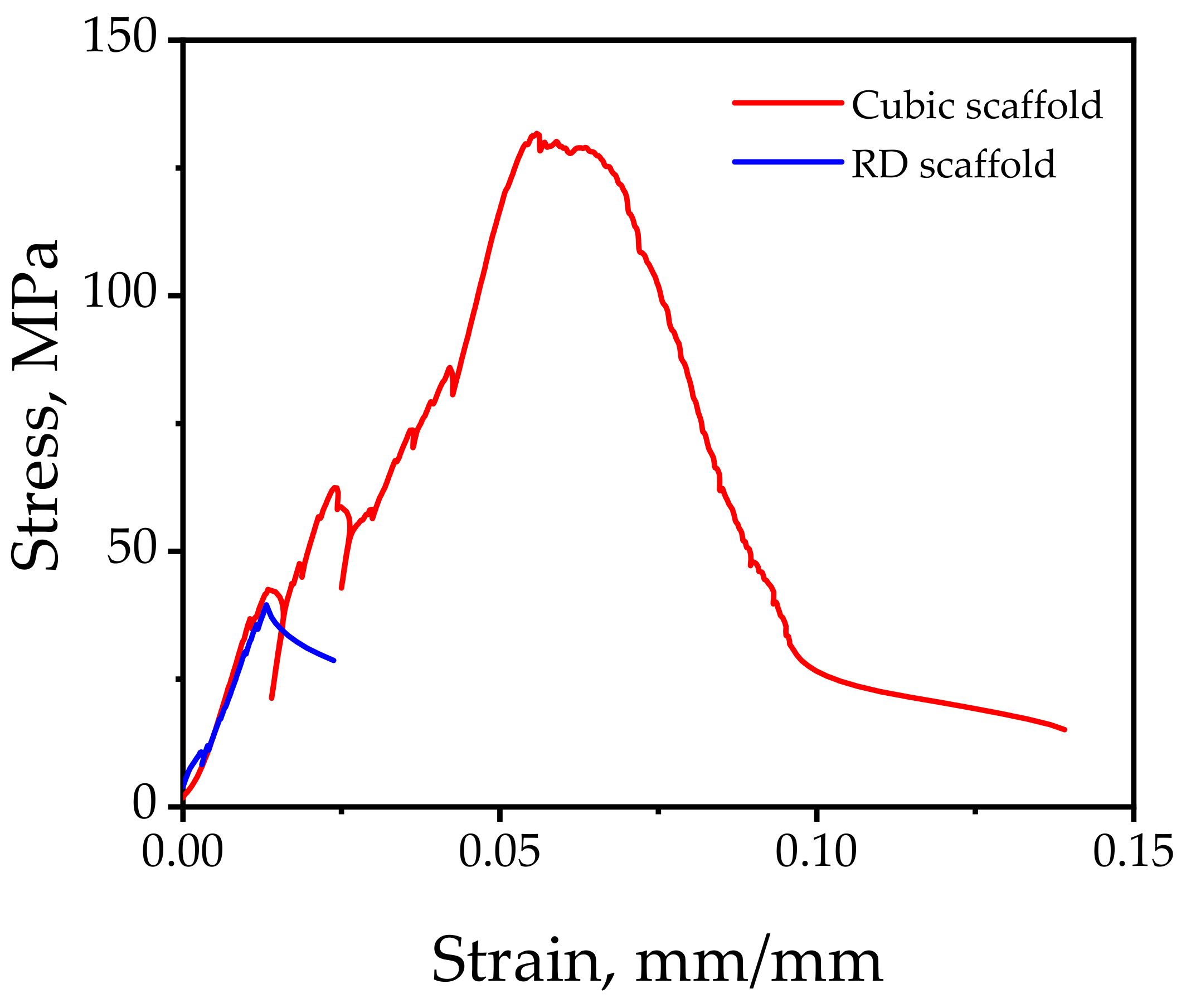
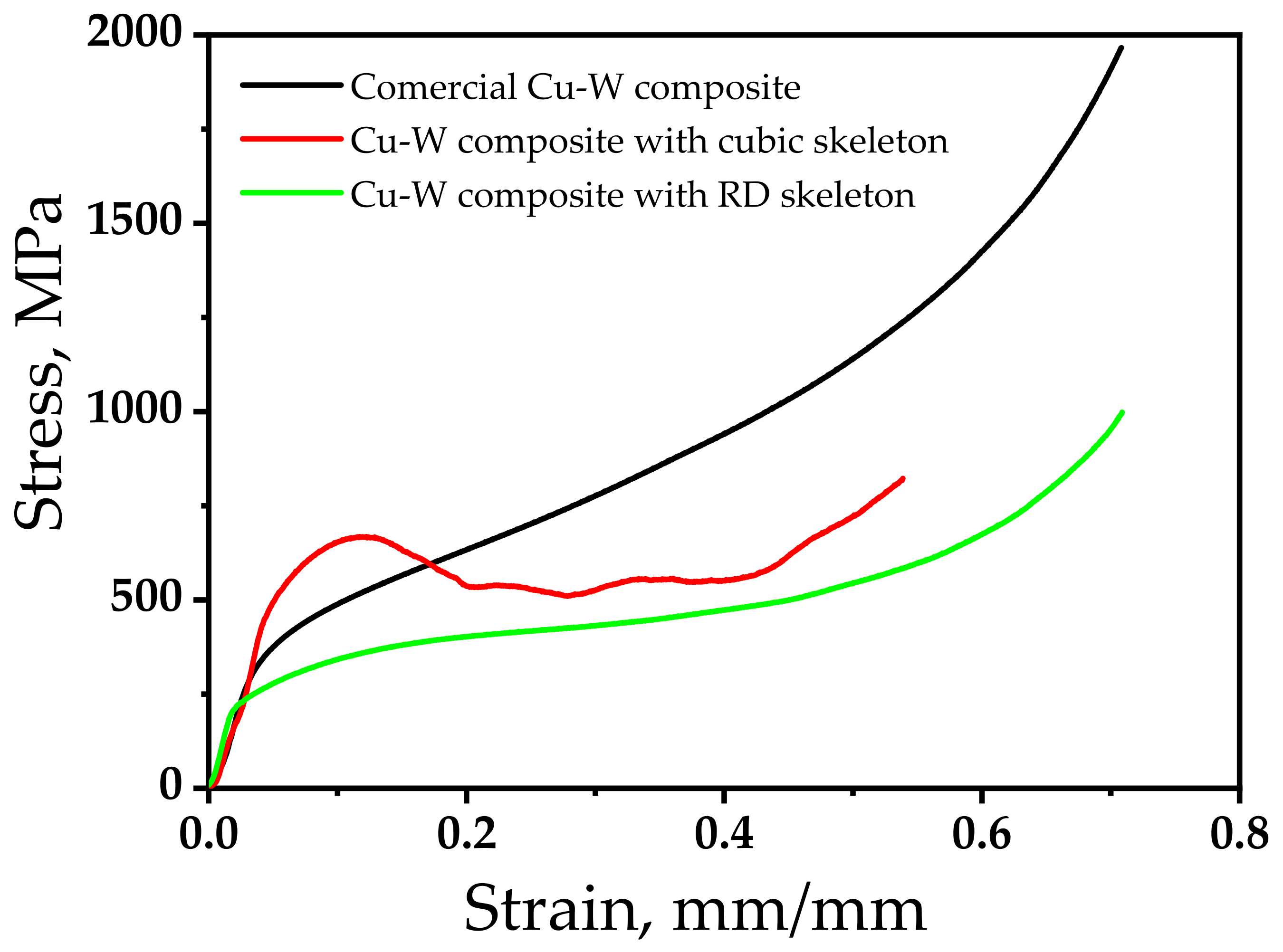
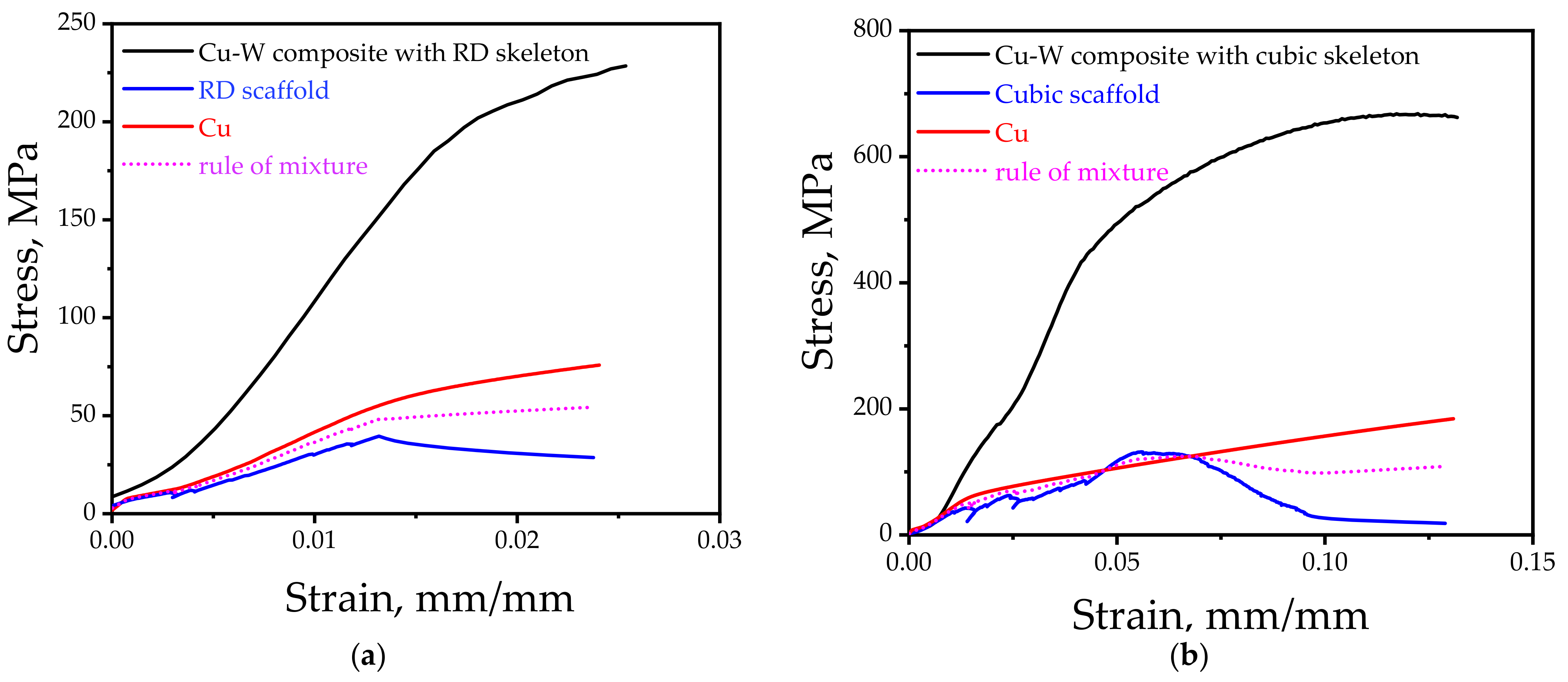

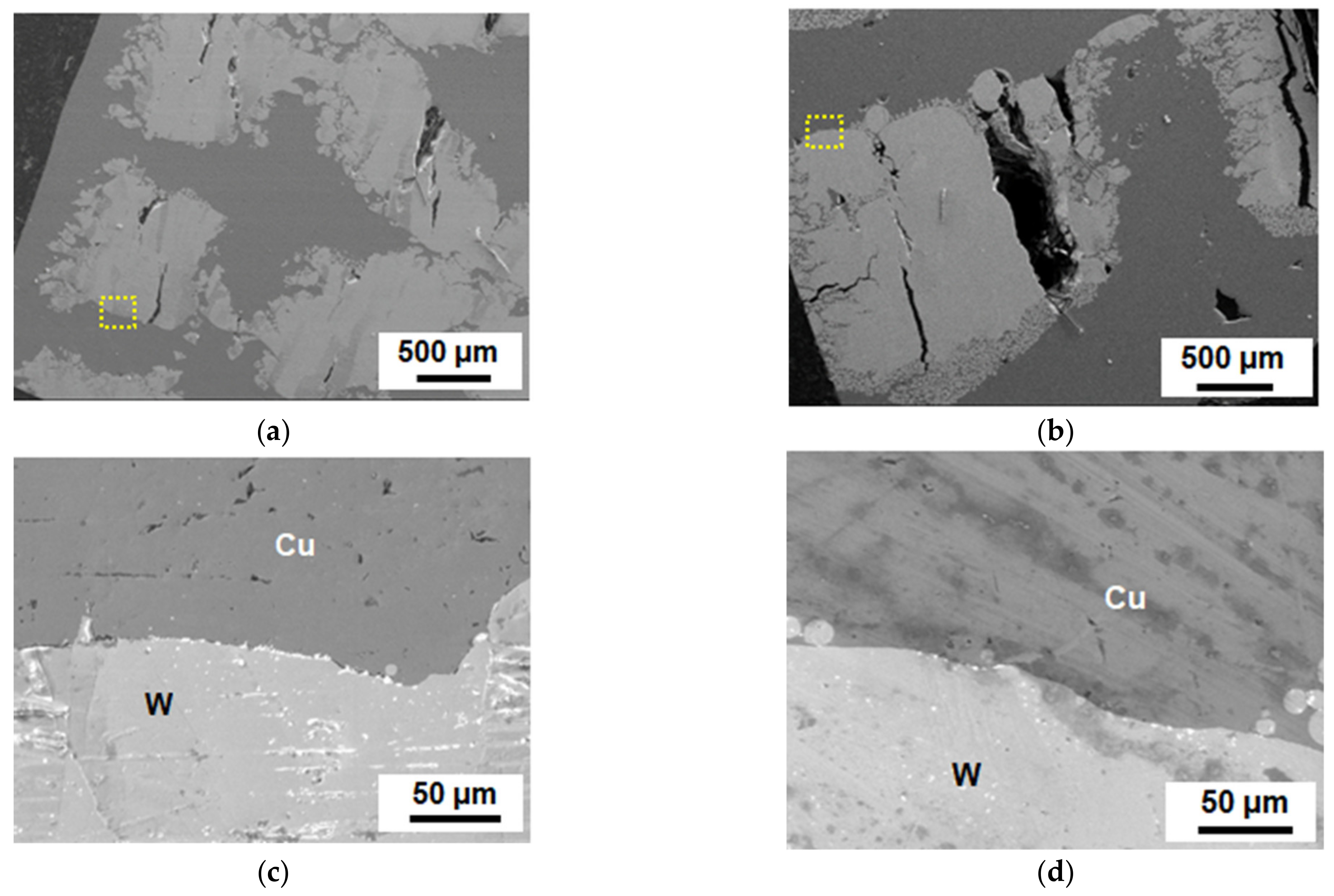
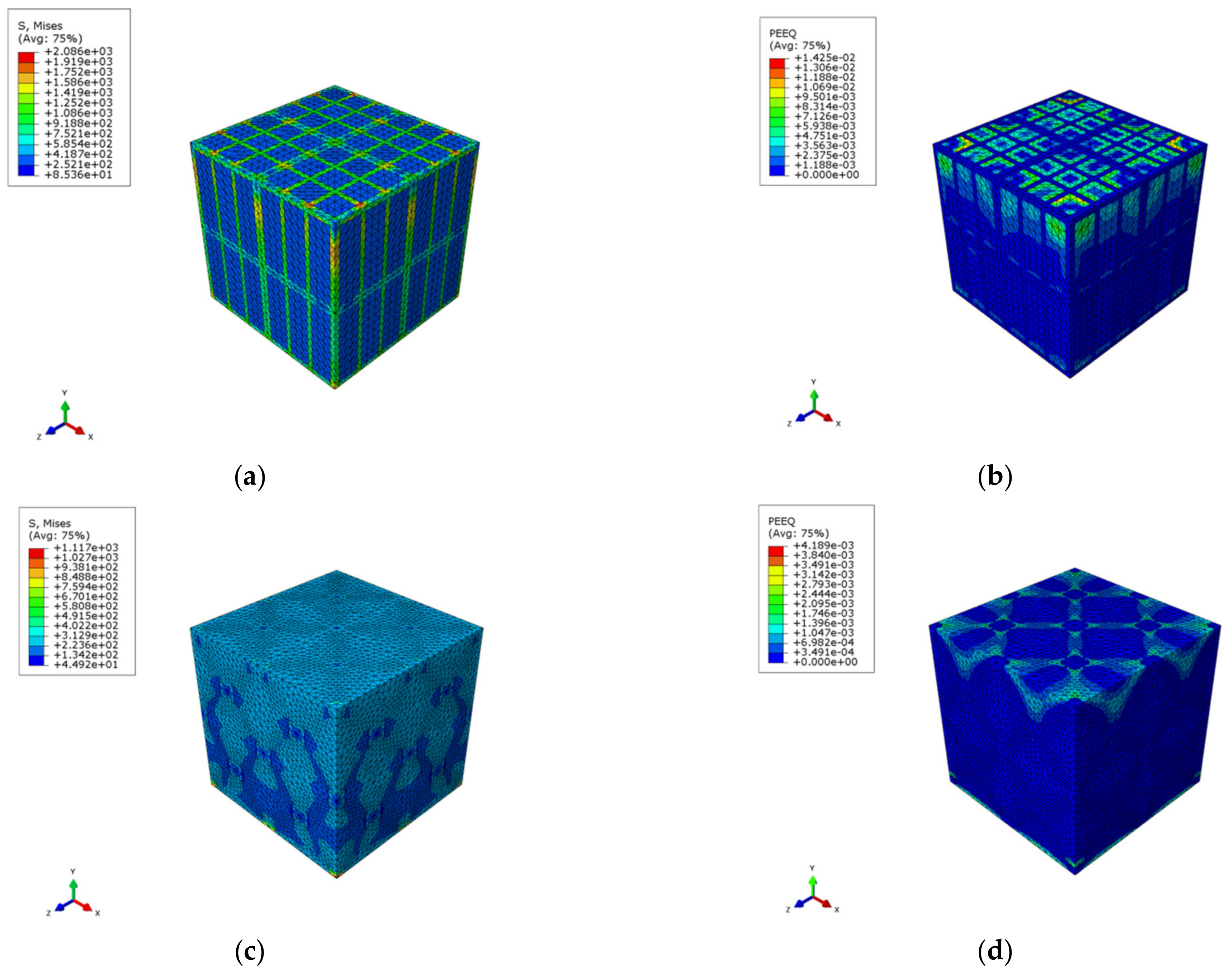
Publisher’s Note: MDPI stays neutral with regard to jurisdictional claims in published maps and institutional affiliations. |
© 2022 by the authors. Licensee MDPI, Basel, Switzerland. This article is an open access article distributed under the terms and conditions of the Creative Commons Attribution (CC BY) license (https://creativecommons.org/licenses/by/4.0/).
Share and Cite
Han, Y.; Li, S.; Cao, Y.; Li, S.; Yang, G.; Yu, B.; Song, Z.; Wang, J. Mechanical Properties of Cu-W Interpenetrating-Phase Composites with Different W-Skeleton. Metals 2022, 12, 903. https://doi.org/10.3390/met12060903
Han Y, Li S, Cao Y, Li S, Yang G, Yu B, Song Z, Wang J. Mechanical Properties of Cu-W Interpenetrating-Phase Composites with Different W-Skeleton. Metals. 2022; 12(6):903. https://doi.org/10.3390/met12060903
Chicago/Turabian StyleHan, Ying, Sida Li, Yundong Cao, Shujun Li, Guangyu Yang, Bo Yu, Zhaowei Song, and Jian Wang. 2022. "Mechanical Properties of Cu-W Interpenetrating-Phase Composites with Different W-Skeleton" Metals 12, no. 6: 903. https://doi.org/10.3390/met12060903
APA StyleHan, Y., Li, S., Cao, Y., Li, S., Yang, G., Yu, B., Song, Z., & Wang, J. (2022). Mechanical Properties of Cu-W Interpenetrating-Phase Composites with Different W-Skeleton. Metals, 12(6), 903. https://doi.org/10.3390/met12060903




